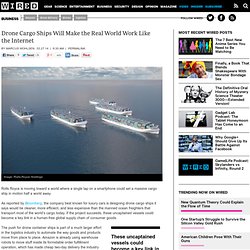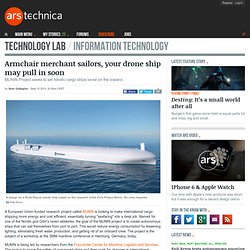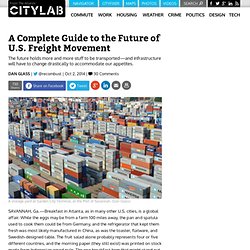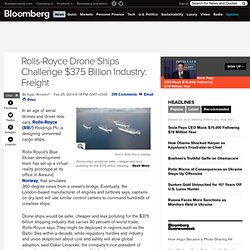

A vision of the port of the future, 100 years after the birth of the container. Drone Cargo Ships Will Make the Real World Work Like the Internet. Image: Rolls-Royce Holdings Rolls Royce is moving toward a world where a single tap on a smartphone could set a massive cargo ship in motion half a world away.

As reported by Bloomberg, the company best known for luxury cars is designing drone cargo ships it says would be cleaner, more efficient, and less expensive than the manned ocean freighters that transport most of the world’s cargo today. If the project succeeds, these uncaptained vessels could become a key link in a human-free global supply chain of consumer goods. Armchair merchant sailors, your drone ship may pull in soon. A European Union-funded research project called MUNIN is looking to make international cargo shipping more energy and cost efficient, essentially turning "seafaring" into a desk job.

Named for one of the Nordic god Odin's raven sidekicks, the goal of the MUNIN project is to create autonomous ships that can sail themselves from port to port. This would reduce energy consumption by lessening lighting, eliminating fresh water production, and getting rid of an onboard crew. A Complete Guide to the Future of U.S. Freight Movement. SAVANNAH, Ga.

—Breakfast in Atlanta, as in many other U.S. cities, is a global affair. While the eggs may be from a farm 100 miles away, the pan and spatula used to cook them could be from Germany, and the refrigerator that kept them fresh was most likely manufactured in China, as was the toaster, flatware, and Swedish-designed table. The fruit salad alone probably represents four or five different countries, and the morning paper (they still exist) was printed on stock made from Indonesian wood pulp. The one breakfast item that might stand out as clearly "foreign" might be the coffee from Ethiopia. Regardless of national origin, pretty much all of it came from outside Atlanta, by means ranging from 1,200-foot-long container vessel to oxcart.
The scale of the infrastructure that moves our stuff is staggering, yet we hardly notice it beyond appreciating how fast a book has arrived or growing agitated with double-parked delivery trucks. Shipping companies like big ships. Cargo ship's hull acts as giant sail. Vindskip Promo 2013. The next revolution in cargo will be the container ship drone. Rolls-Royce Drone Ships Challenge $375 Billion Industry: Freight.
In an age of aerial drones and driver-less cars, Rolls-Royce (RR/) Holdings Plc is designing unmanned cargo ships.

Rolls-Royce’s Blue Ocean development team has set up a virtual-reality prototype at its office in Alesund, Norway, that simulates 360-degree views from a vessel’s bridge. Eventually, the London-based manufacturer of engines and turbines says, captains on dry land will use similar control centers to command hundreds of crewless ships. Drone ships would be safer, cheaper and less polluting for the $375 billion shipping industry that carries 90 percent of world trade, Rolls-Royce says.
They might be deployed in regions such as the Baltic Sea within a decade, while regulatory hurdles and industry and union skepticism about cost and safety will slow global adoption, said Oskar Levander, the company’s vice president of innovation in marine engineering and technology. Related: Pdf - Voyaging into the Future. The Box That Built the Modern World - Issue 3: In Transit. It was 11:30 am on a sunny Tuesday in mid-April, and the Hong Kong Express had been docked at Hamburg’s Container Terminal Altenwerder for exactly 33 hours.

Already, the ship was half empty. Cargo from Asia was stacked in neat rows of shipping containers on the dock. Standing in its shadow, it’s hard to appreciate just how big the Hong Kong Express is. From stem to stern, it’s 1,200 feet, nearly a quarter of a mile; from side to side it’s 157 feet, about as wide as some mega yachts are long. Fully loaded, it can carry 13,167 20-foot-long containers, the standard box used in commerce around the world.
As the spring sun climbed higher, glinting off the placid Elbe River, some cranes nestled containers into towering metal racks on the ship’s deck while others lifted boxes out. Before Wednesday dawned, the Hong Kong Express would be underway once more, sailing 70 miles down the Elbe to its mouth on the North Sea. After a brief stop, the vessel worked its way north. “A box is a box.